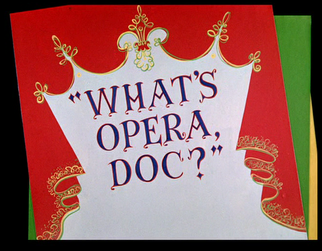
What's Opera, Doc? is a 1957 American animated cartoon short in the Merrie Melodies series, directed by Chuck Jones for Warner Bros. Cartoons.[1] The Michael Maltese story features Elmer Fudd chasing Bugs Bunny through a parody of 19th-century classical composer Richard Wagner's operas, particularly Der Ring des Nibelungen (The Ring of the Nibelung) and Tannhäuser. It is sometimes characterized as a condensed version of Wagner's Ring Cycle, and its music borrows heavily from the second opera Die Walküre, woven around the standard Bugs-Elmer conflict.
Originally released to theaters by Warner Bros. on July 6, 1957, What's Opera, Doc? features the speaking and singing voices of Mel Blanc and Arthur Q. Bryan as Bugs and Elmer respectively. The short is also sometimes informally referred to as ''Kill the Wabbit'' after the line sung by Fudd to the tune of Wagner's "Ride of the Valkyries", the opening passage from Act Three of Die Walküre (which is also the leitmotif of the Valkyries).
In 1994, What's Opera, Doc? was voted #1 of the 50 Greatest Cartoons of all time by 1000 members of the animation field.
Plot
The screen pans on the silhouette of a mighty Viking (presumably Thor) arousing ferocious lightning storms, but then zooms in to reveal that it is only Elmer Fudd (as the demigod Siegfried). Elmer sings his signature line "Be vewy qwiet, I'm hunting wabbits" (in recitative), before he finds rabbit tracks and arrives at Bugs Bunny's hole. We watch as Elmer jams his spear into Bugs's hole to "Kill the wabbit! Kill the wabbit! Kill the wabbit!" Bugs sticks his head out of another rabbit hole, and, apparently appalled, sings his signature line "What's up, doc?" to the theme of Siegfried's horn call from the Ring Cycle. He asks Elmer how he will kill the rabbit, then taunts Elmer about his "spear and magic helmet". This prompts a display of Elmer-as-Siegfried's "mighty powers", set to the overture of The Flying Dutchman, which causes lightning to strike the tree next to Bugs. At that, Bugs flees, Elmer realises that was the rabbit, and the chase begins.
Suddenly, Elmer is stopped in his tracks at the sight of the beautiful Valkyrie Brünnhilde (Bugs in an obvious disguise), riding in grandly on an enormously fat horse (in Chuck Amuck: The Life and Times of an Animated Cartoonist, director Jones notes that the production team "gave the horse the operatic curves we couldn't give Bugs"). "Siegfried" and "Brünnhilde" exchange endearments, set to the "Pilgrims' Chorus" theme from Tannhäuser as orchestrated in the opera's overture.
After the usual "hard to get" pursuit they perform a short ballet (based on the Venusberg ballet in Tannhäuser), capping it off with the duet "Return My Love" set to another section of the Tannhäuser overture. Bugs' true identity is suddenly exposed when his headdress falls off, enraging Elmer and prompting him to command fierce lightning, "typhoons, hurricanes, earthquakes" and, finally, "SMOG!!!" (a word Elmer screams which was not done by Bryan, but by Blanc[2]) to "stwike da wabbit!" while music from The Valkyries plays in the background.
Eventually, the ensuing storm tears apart the mountains where Bugs has fled. Elmer triumphantly rushes to see his victory, but upon seeing the bunny's seemingly lifeless body, which is strangely intact, Elmer immediately regrets his wrath and tearfully carries the bunny off, presumably to Valhalla in keeping with the Wagnerian theme, per Act III of The Valkyries (although the music again comes from the overture to Tannhäuser). Bugs suddenly raises his head to face the audience and remarks, "Well, what did you expect in an opera? A happy ending?", ironically undoing the intended sad conclusion. The Merrie Melodies end title card then appears with all the words already there.
This cartoon marks one of only three times that Bugs Bunny is defeated by Fudd. The other two are Rabbit Rampage and Hare Brush. That is also the only one of the three where Fudd shows regret for defeating Bugs.
Wagner's music
When presented in the 1979 compilation The Bugs Bunny-Road Runner Movie, Bugs Bunny claims that the short was the whole of Wagner's 17-hour Opera Cycle "Der Ring des Nibelungen" (The Ring of the Nibelung, which he mispronounced as "The Rings of Nibble-lung" in his Brooklynese accent), condensed into only 7 minutes. He also pronounced Richard Wagner the way it looks (wag-ner), instead of Rikard Vagner. Besides the second opera of Ring, Die Walküre (The Valkyrie) and the third opera of the Ring, Siegfried, other Wagnerian music present in the cartoon comes from Tannhäuser and Der fliegende Holländer (The Flying Dutchman). Specific excerpts include:
- The overture from The Flying Dutchman — opening storm scene
- Siegfried's horn call from Siegfried — "O mighty warrior of great fighting stock"
- The overture and "Pilgrims’ Chorus" from Tannhäuser — "O Bwünnhilde, you'w so wuvwy," "Return my love," and the closing scene
- The overture from Rienzi— as Elmer is chasing Bugs.
- The Bacchanal from Tannhäuser — ballet scene between Elmer and Bugs
Awards
This cartoon is widely regarded as Chuck Jones’ masterpiece, and many film critics, animation fans and filmmakers consider it to be the greatest of all the cartoons Warner Bros. released. It has topped many Top Ten lists of the greatest animated cartoons of all time. It was rated by a panel of over 1000 animators in Jerry Beck's 1994 book The 50 Greatest Cartoons: As Selected by 1,000 Animation Professionals as the #1 greatest cartoon of all time.[3]
In 1992 it became the first cartoon short to be deemed "culturally, historically, or aesthetically significant" by the United States Library of Congress, and was selected for preservation in the National Film Registry. Duck Amuck and One Froggy Evening were later inducted into the registry, making Chuck Jones the only animator with three shorts thus recognized. It is currently the only Bugs Bunny short listed in the National Film Registry.[4]